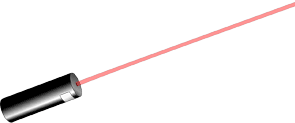Ray
A ray is a geometric object that has one endpoint from which it extends infinitely. It can be thought of as being part of a line with the key difference being that a line extends infinitely in two directions, while a ray only extends infinitely in one direction. The figure below is an example of a ray:

In the figure above, ray AB, written symbolically as , contains all of the points on line
from A in the direction of B. Notice that the notation for a ray and a line also reflect that a ray extends in one direction while a line extends in both directions.
What is a ray
A ray is a geometric object that begins at an endpoint and extends infinitely in one direction. Below is a real life example of a ray as well as examples of rays in various mathematical contexts.
1. A laser pointer creates a ray of light.

The starting point is the base of the laser pointer from which the ray extends infinitely (though we may not actually be able to see this).
2. The number line below is a ray that indicates the set of whole numbers. It begins at the endpoint 0 and extends towards infinity.

3. In coordinate geometry, an inequality can be represented as a ray on a number line.

The inequality x ≥ -1 can be represented by the ray above, whose endpoint is at -1 on the real number line.
How to name a ray
A ray is named by first identifying the endpoint, which determines the starting point of the ray. All rays have only one endpoint. The other end of the ray extends infinitely. To name a ray, a minimum of 2 points on the ray must be known. Given an identifiable endpoint and another point, the steps for naming a ray are as follows:
- Identify the endpoint of the ray. This is always the first point referenced when naming the ray.
- Identify a second point on the ray.
- Name the ray by listing the two points, with the first point being the endpoint; to indicate that the letters represent a ray, draw a right arrow above the letters.
The figure below shows two different rays, and
:


How to name a ray with 3 points
If there are more than 2 points, the ray can be named by the endpoint and any other point on the ray. The endpoint must be one of the points named, and it must be the first point in the name of the ray:

The example above shows that it doesn't matter whether point B or point C is the second point used to name the ray, as long as the first point (the endpoint) is A.
Angles and rays
An angle is formed when two rays share a common endpoint. The point at which the rays meet is called the vertex of the angle. The rays are called the "arms" of the angle.

Angles are measured in degrees (°) or radians based on the arc between the two rays.
Did you know?
A ray of sunshine begins at the sun (the endpoint) and travels through space in one direction. A ray from the sun can be used as a model for thinking about a ray in geometry.

